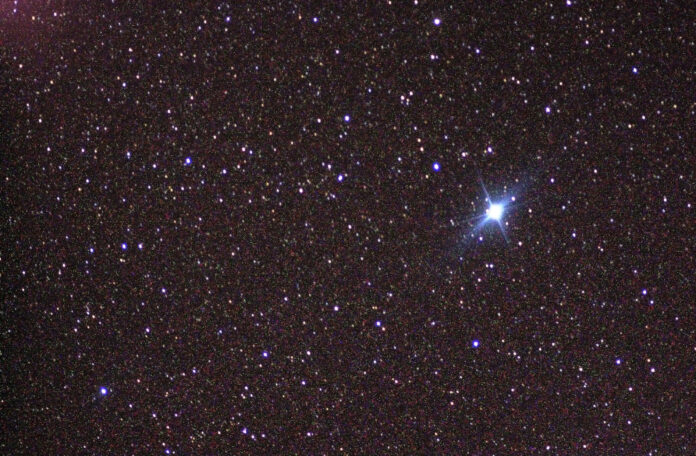Canopus is the brightest star in the constellation Carina, among its 206 constituent stars. It is the second-brightest star in our sky with a visible brightness to the naked eye (after Sirius).
Ancient Arabic astronomers discovered Canopus several thousand years ago. According to one version of the name’s origin, the star is named after a helmsman of King Menelaus of Sparta. It is also known as Suhail.
For the Bedouins of the Sinai Peninsula, Canopus has always served as a nighttime landmark when combined with the Pole Star. Before the compass was invented, sailors actively used it for navigation. Since 1964, it has also become an official aid in space navigation.
Canopus is classified as a supergiant of spectral class F0, as its radius is nearly 65 times that of the Sun.
Key Characteristics of the Star Canopus:
- Yellowish-white supergiant (a representative of a rare type of stars).
- Age: 100 million years.
- Distance from the Solar System: 96 parsecs (310 light-years, determined only in 1990).
- Mass: about 9 solar masses.
- Radius: about 50 million km (65 times larger than the Sun).
- Surface temperature of the star: about 7000 degrees Celsius.
- Rotation speed: 8 km/s.
- Luminosity of Canopus: It is approximately 15,000 times more luminous than the Sun. The greatest in the radius from the Sun within 700 light-years.
The speed of X-ray emission from the star’s hot corona is about 22 km/s.
It appears less bright than Sirius solely due to its relatively insignificant astronomical distance from Earth.
Interesting Facts about the Star Canopus:
- Inhabitants of the Southern Hemisphere can see the star year-round with the naked eye, while those in low latitudes of the Northern Hemisphere can see it only in winter. Unfortunately, Russia is not among the lucky ones.
- Canopus lies on the imaginary line Sirius-South Pole of the world.
For reasons that have not reached us, the Chinese referred to Canopus as the “star of death.” - The star gave its name to a class of sail-powered battleships of the British Navy in the 19th century and two generations of submarines of the U.S. Navy.
Canopus is one of the corners of a right triangle formed with the star Achernar and the South Pole of the world. - For the Persians, Canopus was inexplicably considered a synonym for wisdom.
Canopus approached the Sun over 3 million years ago at a distance of over 170 light-years. - The supergiant serves as the harbinger of the rainy season in Botswana, Africa.
Mountains named Canopus are located in the territory of the southernmost continent of Earth, Antarctica, and the Australian island of Tasmania. - Canopus is the leader among stars in terms of the number of its own names.
The star is used in astrocorrection systems based on signals from star sensors and serves as a landmark for launching rockets by space stations. - There is a version suggesting Canopus might end its lifecycle with an explosion, forming a supernova, and transforming into a white dwarf with a large planetary nebula.
- Canopus earned a place on the flag of Brazil, representing the greenest state of Goias.
It is possible (not yet confirmed by scientists) that Canopus forms a binary star pair with a red dwarf.
